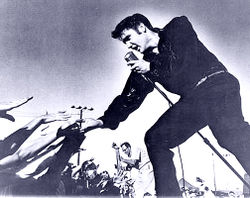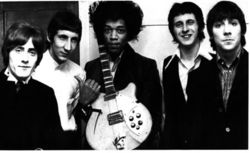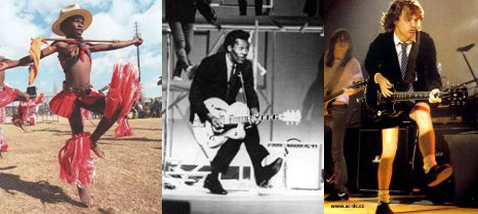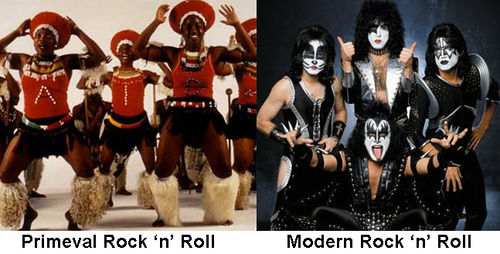User:Sog1970/rnr2
Professor Dwayne McJingo’s History of Rock and Roll
People of a PBS disposition say that Rock and Roll is a black art form performed by white musicians to white audiences, for the profit of white record executives. As Grand Imperial Jade Dragon of the Kentucky Klan, I say “Good!” However, did good Aryan boys like Richie Valens, Bob Dylan or Lenny Kravitz really need to copy the primitive rhythms of Africa to make the kind of music that seems only to move white kids? The considered answer to that question is – “Hell, no!” And if you still disagree after reading this treatise, we have plenty of spare rails to run you out of town on and enough tar to feather half of Arkansas.
The first Rock ‘n Rollers[edit | edit source]
In 1948, Teenagers were invented and, with them, the need to find innovative ways to make them spend their money. Executives at Parlophone Records commissioned one of the first commercial opinion polls in US history to discover why this new demographic did not take to the wholesome offerings of Perry Como and the Andrews Sisters with quite the same enthusiasm as their parents. It seemed that gentle ballads concerning Mommy kissing Santa Claus under the mistletoe or the blueness of the moon, simply did not connect with an age group more interested in discovering the contents of their opposite gender’s underwear.
Parlophone realized that the invention of the electric guitar, the development of 45 rpm records and the advent of cheap electronic amplification suited music which combined a boogie-woogie swing rhythm with an accentuated backbeat. But where could they find artiste’s to record this innovative sound? In February 1949 Parlophone dispatched a party of their finest A & R men to the Deep South to search for performers who could deliver this youth-orientated style with swagger while proclaiming their interest in procreation without embarrassment. Despite an extensive eight month investigation of every state south of the Mason-Dixon Line, they failed to meet even one of the many performers who are these days thought of as the initiators of Rock and Roll.
“We looked everywhere,” wrote Steve Jennings, Head of Corporate Talent. “But no one seemed to fit the bill. We did hear of one guy down there who sounded promising. He called himself Chuck Bèrré – Cajun, I guess. We invited him for a meeting but he didn’t show - said they wouldn’t let him in the hotel unless he wore a waiter’s uniform. They must have thought he was Jewish, or something.”
Instead, it fell to Sun Records to release the first universally acknowledged Rock and Roll classic in 1954. And even that momentous event owed more than a little to luck. In January of that year, unemployed truck driver Elvis Presley happened to be walking through a municipal park in Memphis, Tennessee. Unable to pass up the opportunity of a free lunch, he chased a lame squirrel through the park-gates and along a busy street before cornering it the office of Sam Phillips. So impressed was the Sun supremo by Presley's noises of appreciation as he ripped apart that raw squirrel that, within six weeks, “That’s all right, Mama” had been recorded, released and become a coast to coast smash. This despite persistent suggestions in [[liberal|The New Yorker] that Presley’s poorly enunciated words had more to do with Negro-speak than a simple mouth full of rodent. Irrespective, Rock music was on a roll and would gather no moss for years to come.
The Origin of Rock ‘n Roll[edit | edit source]
Liberals say that Rock and Roll relies on Blues rhythms inherited from African slaves. But even the most cursory research into the History of the Billboard chart shows that Blues developed in 1962 in the working class districts of English cities like London. Who ever heard “Little Red Rooster” before Mick Jagger introduced us to him? And, if the much vaunted black musicians of Louisiana are all they’re cracked up to be, why did it take a bunch of hairy-assed Mancunians to tell them all about that famous house in New Orleans they called The Rising Sun?
The truth is that Rock and Roll developed long before the Blues. As is clear in even school textbooks and PBS documentaries, all cavemen were white. The very name of the Stone Age indicates that these guys knew all there was to know about Rock. It is hardly a surprise that, in banging them together in search of fire, they came across the kind of primeval beat that still moves us. Assuming there were black guys at this point in human history, they simply didn’t have the sense of rhythm to contribute. And not surprising, as they watched their girls dance around the camp-fire they would have been too mesmerized by the bouncing boobies to think about banging anything but their girlfriend.
Some thousands of years later, Christian gentlemen-traders of Europe stopped by and kindly gave thousands of Africans a lift across the mighty Atlantic and steady employment in the fields of their colonial cousins. It was then that the basic white rhythms transferred to the dark races and was immediately perverted into unholy forms of music, like Jazz and Gospel.
Merrie Olde Englande[edit | edit source]
For a while the music of Jerry Lee Lewis, Conway Twitty, Fabian, and Brenda Lee ruled the airwaves and dominated the Jukeboxes of the nation. But by 1959, Rock ‘n Roll was in seemingly terminal decline; Elvis was protecting the free world from Communism by heroically enlisting in the US Army’s European Concert Party, The Big Bopper’s morbid obesity had brought about a terminal aneurism and Buddy Holly had learned the hard way the necessity of lowering the undercarriage before landing light aircraft.
But all was not lost. In the port cities of Britain, young people had learned of the invention of teenagers from American sailors in search of friends. They listened to imported 45s and began to play their own version of the music spearheaded by Cliff Richards and Billy Fury. In Liverpool, a city devastated by the Luftwaffe only 15 years earlier, a particular genre emerged which was christened “Merseybeat” in honor of the River Thames. They decided to seek vengeance for the suffering of their parents by exporting “Rory Storm & the Hurricanes” and “Gerry & The Pacemakers” to Hamburg.
Within a few short years of 1962, British Rock ‘n Roll bands held sway in UK and European charts and felt that the time was right to extend musical vengeance. The War of 1812 has long rankled in the British psyche, it was time to reverse American incursions into the Empire – The British Invasion was born.
By 1965 it took little more than a Carnaby Street suit, fashionable haircut and a Cockney accent to gain a US recording contract. Musical ability was entirely optional – a fact demonstrated admirably by the success of Herman’s Hermits.
But it was The Pretty Things, headed by drummer Viv Prince, and The Who, headed by drummer Keith Moon, who were the first to really introduce utter chaos into the mix, and thus The British sound became defined as brash, destructive, illegal, loud, Mod (and Rockers), and harmonic. Crowds of angry teenagers across England had their souls released by the sustain and feedback of Jeff Beck, as well as the antics of Pete Townshend's smashing his guitar over his amps and doing leaping windmills that, for a moment, The Who defined Rock and Roll, forever.
For most, however, it was those good Christian boys The Beatles and The Stones who were both the good boys and bad boys of Rock. Together with the mini-Beatles (The Animals), The Yardbirds, and Petula Clark, they invaded America to seek revenge in what was a great victory, The British Invasion. Ed Sullivan (secretly working for MI6) introduced American teenagers to the concept of an actual, "Band" - as opposed to a solo singer with backup, as was usually the case before the Brits Hit the Parade. Teenagers, girls in particular, went totally insane, screaming and crying, and all the American boys thought, "Damn, let's make us a band and get these weepy girls in my pants too!"
Psychedelic Music[edit | edit source]
Adding drugs to the musicians gave rise to Psychedelic music, which was powerful enough to induce Ludwig van Beethoven to roll over and to drive the North Vietnamese so insane that they decided to liberate their own country. With primeval big-beat at its heart Rock's bastard child, Psychedelic music, was quite possibly conjured up by none other than the great Dr. Timothy Leary who gave LSD to the Mothers of Invention, The Third Bardo, The Beatles, The Yardbirds, Big Brother and The Holding Company, The Doors, and other unsuspecting bands, who emitted a collective "Whoa!" - and proceeded to turn their amps up to eleven to pay homage to feedback and distortion, and to scare away the evil geckos which had occupied their Hendrix-perms.
It is interesting to note that while American Psychedelia concentrated on the colour of white rabbits and the need to feed one's head rather than inserting food into other parts of the body, British psychadelic music tended to focus on pastoral themes, nursery rhymes and little gnomes named Grimble Cromble. Either way, the music was generally amplified to amplitudes beyond human hearing and was best appreciated from several miles away, hence the development of the Rock festival at this point.
The resulting cacophony stirred intensely curious strangelings who, together with the dregs of an entire generation, joined Dr. Leary and began expounding on Bhardo Thodal - instant enlightenment through ingesting sacred mushrooms, LSD, and other mind-altering substances such as paint thinner, model airplane glue, and dried banana peels. Mind-expanding drugs opened the doors of perception to many during the late 1960s, the subtle catch being that the open doorway led to nothingness or voidism. Many Psychedelic musicians became only to aware of the meaning of nothingness as this was precisely the sum payable to them by record companies following signature of innovative management agreements. In order to make money and get laid, the majority of Psychedelic bands, changed their name and devolved into heavy metal outfits or Hard Rock bands - collectively known by the term "garage" after the place most teens stored their extensive collection shortly after their twenty first birthdays. From Garage evolved every other type of Rock and Roll, more than likely.
Jigger Myth: Rock and Roll music comes from the Blues[edit | edit source]
According to a bunch of savages who is always tryin' to take credit away from the white master race Rock ‘n’ Roll started with Leroy and Sapphire Ubangoo'luu – in the Garden of Africa. They wrongly say rock can be traced back to the Stone Age. But in the Garden of Eden the white cavemen had no rhythm - so while there were stones aplenty, still there were no white rockers. So the niggers claim that in the Garden of Africa the black man took two rocks and banged them together repeatedly. This banging gave rise to rhythm, and rhythm is the primeval foundation of rock. You can’t have rock without roll. But the black rockers kept rhythm to them selves, only demonstrating rhythm when they held a war party or a peace party or just a get-down ‘bare boobs’ party, which was nearly every day - until the Christians arrived.
Then, they claim, Christian-organized human slavery changed everything. The rock-banging blacks were sold in the new world: cheap. These slaves had lost almost everything, but not their rhythm - they were born rockers. As the times became cotton-picking miserable those rocking blacks started to complain about everything from master to mama. But they didn't just bitch like a white man, they added rhythm to their miserable lives and invented the blues and gospel. Between gospel and blues those blacks were rocking and rolling - and after the great depression (period following the Kennedy assassination) - when white folks were looking for a way to express their frustration besides war - it was none other than the black folks who claimed to lead the way. Sure, lots of rocking blacks played the blues. But that wasn't nothing like Rock and Roll. It was just bitching and rhythm. And white folks said, goddamn those black folks sure do know how to complain to rhythm. But that still wasn't Rock and Roll.
But it wasn't until Chuck Berry that blacks finally dropped all that savage rhythm and blues, and in stead, the started to copy white Rock and Roll – a public outrage. Most American white folks didn't take much notice of all the rhythm - and instead they tried to lock up Chuck Berry lest he corrupt an entire generation of party happy white trash. But it was too late. Elvis and Pat Boone tried to imitate the blacks, just to prove their superiority in spite of they’re being far too civilized. Just imagine Pat Boone singing, “tutty fruity, on a-rooty” - Goddamn!
Civilized White Folks[edit | edit source]
PROGRESS NOTE[edit | edit source]
---Soggy! Champ! A couple things about this article: 1) Dwayne is a racist, and I have a hard time telling this from the point of view of a racist, and 2) It's such a big subject. I really don't know what to do from this angle in the leadership department. But you have a handle on his voice. So I can just feed in material, and hopefully you can convert it to his tone and style. Also, it would be good if you could make an outline of the total picture, with heading titles, so I can see the bottom line. I'll add material into whatever structure you design. The big picture. Let me know, bro!--Funnybony ![]()
![]()
![]() 17:18, Jan 3
17:18, Jan 3




